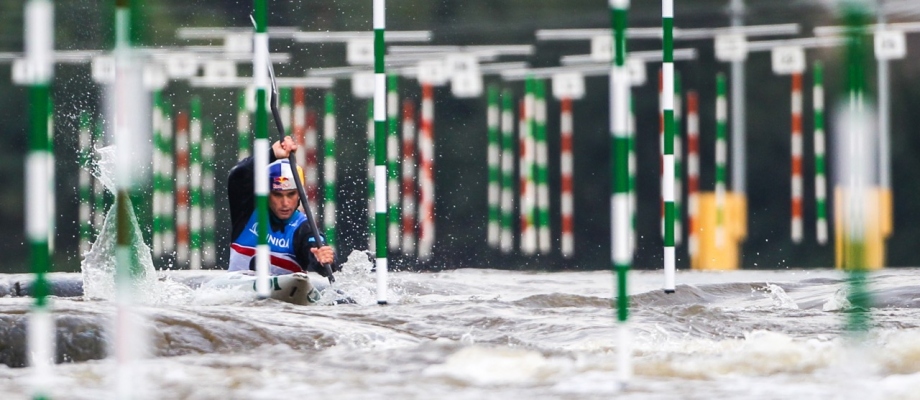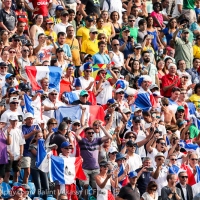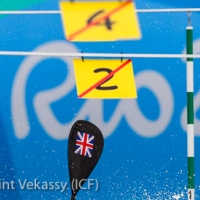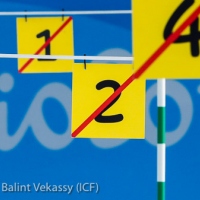The all seeing eye of the judge
Today we continue the theme of looking at the different roles of those that make Olympic canoe slalom a success. Here we focus on the role of the Judge and explain in more depth the rules of canoe slalom.
To win a medal the paddler needs to be fast and likely clean, meaning no penalties. As the run times have continued to get shorter the possibility to win or medal with a 2-second penalty is unusual. The Canadian Men's Doubles, C2M, presents a unique challenge for the Judges. Both paddlers must negotiate the gate without either paddler touching the poles. It is amazing to see these big boats negotiating tight upstream gates with precision.

Canoe slalom has evolved since it reappeared in the Olympic programme in 1992. The shorter, tighter courses and bigger whitewater have resulted in quicker run times. The boats have become shorter and penalties became 2-seconds rather than 5-seconds. The resulting tighter margins can increase the appetite to take risks. Today we likely see more 50-second penalties in the semi-final and finals.
Technology is again transforming the sport, with increased use of real-time video analysis for the purposes of judging. Video technology is now employed to allow examination of video replay to ensure justifiable penalty decisions. There is ICF ongoing investment in the integration of slow motion, SloMo, systems. A Technical Video Service have cameras mounted to relay back video images to a Video Judge section of the Scoring Office. This is independent of any commercial TV coverage.
The race is controlled by the ICF Chief Judge and jury. Top level experienced international judges watch each paddler down the course of gates to determine whether the paddler touches the gate poles and also correctly negotiate the gate.
Penalties in canoe slalom
- A 2-second penalty for touching a pole, irrespective of how many times or whether one or both poles on the same gate are touched.
- A 50-second penalty is awarded when a paddler fails to correctly negotiate a gate, for which there are several potential reasons, but is game over for the paddler on that run.
The paddler must ensure that their head and part of the boat pass through the gate line simultaneously, once only, in the correct direction. A 50-second penalty can be awarded if the paddler’s boat but not their head or body pass through the gate, or if their head and none of the boat, if they are upside down as they pass under the gate line, miss a gate, deliberately displace the gate to allow negotiation or hit a subsequent gate, e.g. gate 12, before attempting gate 11.
The Canoe Slalom Essential post also explores the format and rules
The gates are marked as either red and white (upstream) or green and white (downstream). The number board identifies both the numerical order of the gate and the side from which it should be approached. The back (wrong side) of the gate has a red line through the number showing that correct passage is from the other side of the gate.
The position of the gate is fixed to ensure they are unable to move between paddlers. They are also weighted a little so that they are less affected by the wind, as it is tougher for the paddler to cleanly negotiate a swinging pole than one that is motionless.
Poles can on occasion be set in motion by the water for which the paddler is not penalised. The whitewater can though cause the boat to bounce up under the pole and so the paddler needs to keep their boat balance and paddles upright to avoid any touches.
In the heats, there is a second chance as qualification is the best result from the two runs. In the semi-final, which is only one run, a 50-second penalty will mean the paddler fails to qualify for the final.
Analysis of canoe slalom has shown that penalties are more common on the bottom part of the course as the paddler’s lactic acid builds. One penalty can often knock a paddler off their mental rehearsed plan and sometimes more than one penalty in short succession.

Each gate is observed by several Gate Judges all who have a different view of the gate and so could cover different phases of the negotiation. There is a sizeable technical team of officials working behind the scenes, which also includes the timing team.
The Chief Judge signs off on the official results. The paddler’s equipment is also checked at the end of each run against the requirements. This ensures that the boat meets the respective minimum weight requirement and that the PFD and helmet meet the international standard.
Protests, appeals and tiebreak rules
For judging and timing matters a National Federation Team Manager may make one enquiry per boat, per event, per competition with no fee. The Chief Judge will review all the available information for the processing of the enquiry. Following the investigation of the enquiry the decision of the Chief Judge becomes a matter of fact and cannot be protested further. An enquiry is considered only when submitted within 5 minutes after the competitor’s checklist is posted.
A Team Leader may protest when there is an obvious irregularity in the conduct of the competition. e.g. changing water level, object in the water or change in gate position.
Here you can learn more about what happens in the event of paddlers scoring the same time during the heat, semi-final or final
Keep tuning in
Tomorrow’s posts examine canoe slalom from behind the photographer’s lens and what to expect from the live race commentary.
We welcome your interaction. Remember to use hashtag #ICFslalom across all social media. Please comment through @PlanetCanoe on Twitter





